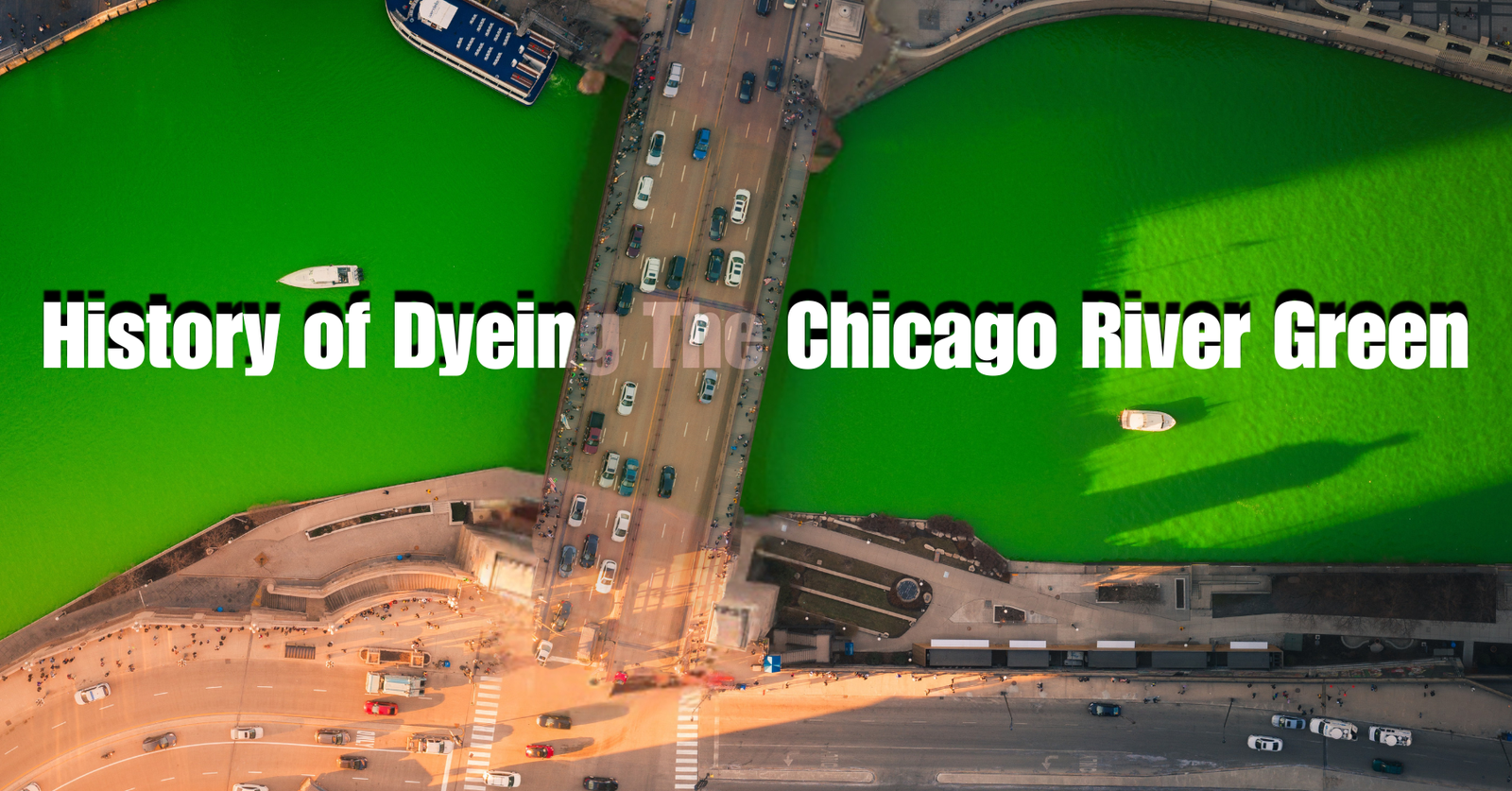
Table of Contents
ToggleIntroduction
St. Patrick’s Day in Chicago is unlike any other celebration in the world. While most cities mark the occasion with parades, green attire, and themed lighting, Chicago takes the festivities to another level with a unique and almost unbelievable tradition: dyeing the Chicago River green.
Every year on March 17, approximately 200,000 Irish descendants and countless tourists gather to honor this legacy, making it one of the most iconic St. Patrick’s Day traditions in Chicago. This event transforms the river into a stunning emerald spectacle, turning the city into a living tribute to Irish heritage.
But how did this extraordinary custom begin? The history of dyeing the Chicago River green traces back over 60 years to an unexpected discovery. The credit goes to Stephen Bailey, business manager of the Chicago Journeymen Plumbers Local Union. One day, he noticed a plumber’s white coveralls were mysteriously stained green. The source? A special dye used to trace leaks and monitor waste flow in the city’s waterways.
Bailey was so fascinated by the sight that he conceived a bold idea: why not dye the Chicago River green for St. Patrick’s Day? This simple yet revolutionary thought led to an annual tradition that has become synonymous with the city’s Irish pride.
For the people of Chicago, the history of dyeing the Chicago River green is more than just an eye-catching spectacle. It represents a deep-rooted cultural celebration that bridges the past and present, blending Irish heritage with the city’s festive spirit. The tradition is not merely about altering the river’s color; it symbolizes Chicago’s heart, history, and its vibrant connection to St. Patrick’s Day.
As we delve deeper, let’s explore how this phenomenon started, evolved, and became an unmissable part of Chicago’s identity.
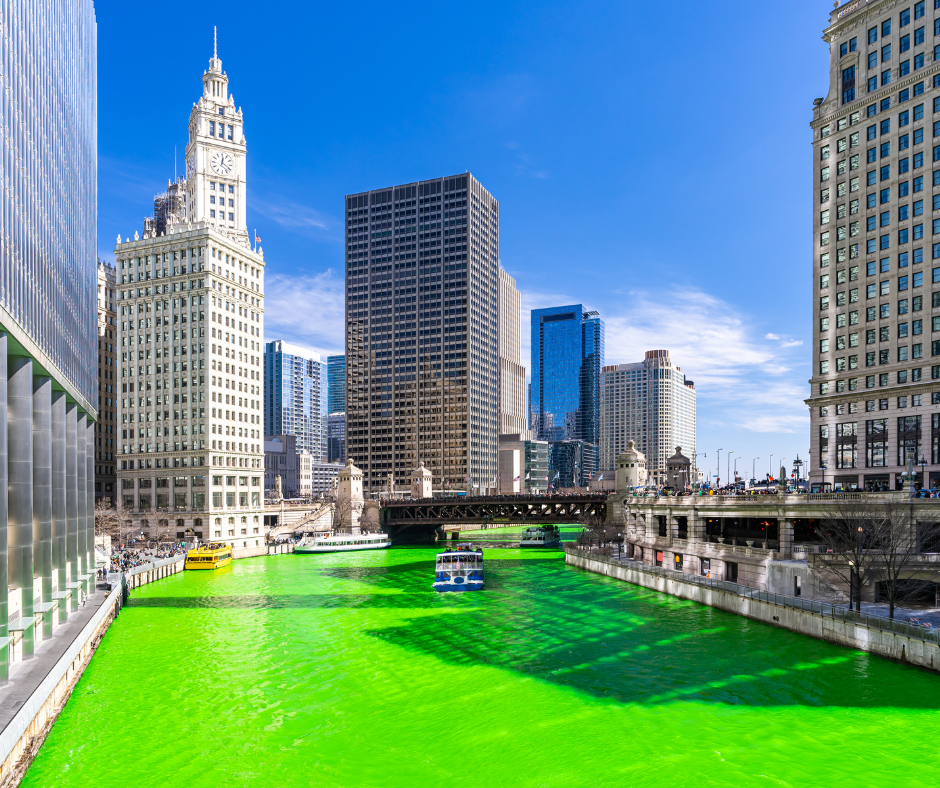
2. Origins of the Tradition
The history of dyeing the Chicago River green officially began in 1962, but its origins trace back to an unexpected discovery. The story took shape when Stephen Bailey, a business manager for the Chicago Journeymen Plumbers Local Union, observed something unusual. While workers were using a special dye—fluorescein—to detect illegal waste discharges into the river, one plumber’s white overalls turned a striking shade of green.
This accidental staining caught Bailey’s attention and sparked a spontaneous idea: what if this same green dye was used to transform the entire river in celebration of St. Patrick’s Day? That simple moment of inspiration laid the foundation for a now-iconic tradition. The history of dyeing the Chicago River green began not as a planned festivity, but as a creative leap born from a practical environmental test.
“What if we used this green dye to turn the entire river green for St. Patrick’s Day?”
This idea resonated with him because St. Patrick’s Day was already associated with a green theme, deeply embedded in Irish traditions. Given Chicago’s significant Irish population, this could become a bold and unique way to celebrate their heritage.
Bailey quickly shared his vision with the Chicago Plumbers Union (Local 130), an essential part of the city’s workforce. The union embraced the concept, and in 1962, they executed the plan for the first time, pouring 100 pounds of fluorescein dye into the river. The process was no small feat; it required meticulous coordination and involvement from multiple people. The reaction was so intense that the river remained green for an entire week.
From that moment on, dyeing the Chicago River green became an official St. Patrick’s Day tradition. However, it was more than just a visual spectacle—it was also a celebration of the city’s deep Irish roots. St. Patrick’s Day is an essential cultural and historical event for the Irish community, and as Irish immigrants settled in Chicago, the tradition evolved to symbolize their enduring presence and contribution to the city’s identity. Over time, this Irish Catholic celebration was embraced by the broader American population, making it one of the most anticipated events in the city.
The tradition was not merely about changing the river’s color. As Stephen Bailey himself once said:
“This green dye will connect the city to Ireland, flowing from the Chicago River to the Illinois River, then into the Mississippi, following the Gulf Stream into the Atlantic Ocean, and ultimately reaching the Irish Sea.”
His words reflected the deep cultural significance of the event—more than just a river-dyeing spectacle, it was a way to symbolically unite Chicago’s Irish community with their homeland across the ocean.
Thus, the history of dyeing the Chicago River green stands as a powerful testament to how a simple yet imaginative idea transformed into a grand annual celebration. It remains a cherished tradition that bridges the past with the present, honoring the city’s Irish heritage while creating an unforgettable experience for locals and visitors alike.
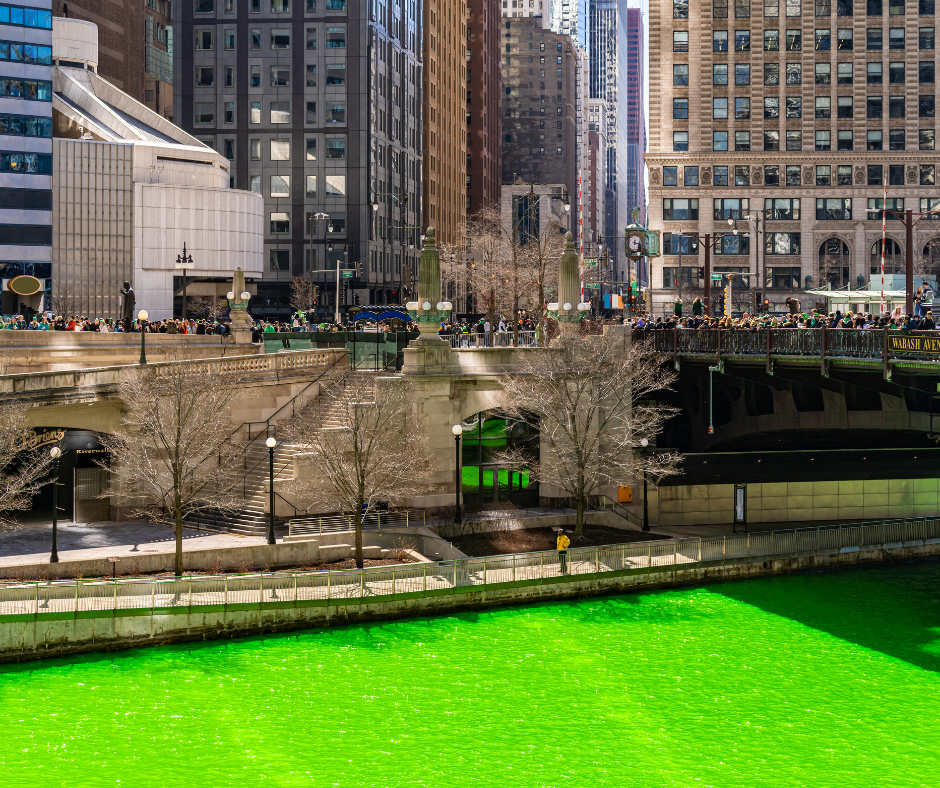
3. The First Green River Dyeing (1962)
n 1962, when the Chicago River was dyed green for the first time, the city witnessed the birth of a spectacular new tradition. This event has since become a celebrated fusion of Irish and American heritage. However, the origin of this practice stemmed from an accidental yet highly creative incident that remains a remarkable chapter in Chicago’s history.
The Need to Identify River Pollution
By the late 1950s, pollution in the Chicago River had reached alarming levels. Waste from various parts of the city was being directly discharged into the river, but city officials were unsure of the exact sources. In response, then-Mayor Richard J. Daley took action, stating:
“We have to clean up this river, but first, we have to find where the waste is coming from!”
To support this initiative, specialists were brought in to investigate, leading to a structured approach to identifying pollution sources:
- Determining which pipes or drainage lines were discharging waste into the river
- Locating leaks or faulty pipes
- Understanding how pollutants were affecting the river’s water flow
How Was Green Dye Used?
The Chicago Journeymen Plumbers Local 130 union was responsible for a crucial part of this investigation. They used a chemical compound known as fluorescein dye, a substance primarily used to detect leaks in water pipes.
The Testing Process
The testing method was straightforward:
- Fluorescein dye was poured into specific drainage pipes.
- After a short wait, officials observed whether the river’s water changed color.
- If the water turned green, it indicated that the pipe was directly connected to the river and was a source of pollution.
- This process was repeated to identify hidden pipelines and leaks contributing to river contamination.
As these tests continued, a pivotal moment occurred—one that led to the now-iconic tradition of dyeing the Chicago River green.
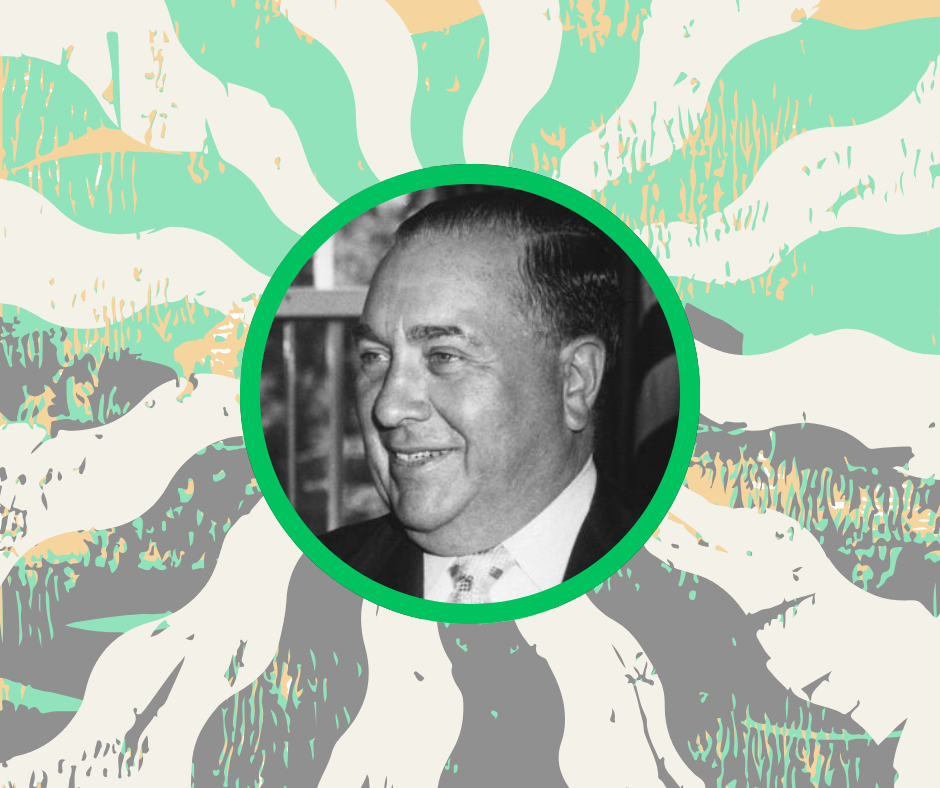
The Accidental Discovery That Started It All
The history of dyeing the Chicago River green began with an unexpected moment. One day, Stephen Bailey, the business manager of the Chicago Journeymen Plumbers Local 130, was overseeing routine dye tests in the river when he noticed something peculiar — a plumber’s white overalls had turned bright green due to accidental exposure to the dye. This vivid sight sparked a creative idea in Bailey’s mind:
“What if we dye the entire river green for St. Patrick’s Day?”
Given the holiday’s strong association with the color green, the idea was quickly embraced. In 1962, for the first time, the Chicago River was dyed green, marking the beginning of what would become a beloved tradition.
Today, the history of dyeing the Chicago River green stands as a symbol of Chicago’s deep Irish roots and has grown into one of the city’s most iconic annual events. More than sixty years later, it continues to captivate both locals and tourists, cementing its place as a vibrant part of the city’s cultural identity.
4. How the River Is Dyed Green
In that same year, the Chicago Plumbers Union used 100 pounds of fluorescein dye to turn the river green in celebration of St. Patrick’s Day—an act that marked a pivotal moment in the history of dyeing the Chicago River green. The water remained vividly green for an entire week, stunning the public and igniting widespread excitement across the city. Onlookers were mesmerized by the transformation, and the river’s vibrant emerald hue quickly became a powerful symbol of a new and festive tradition.
As the green waters flowed through the heart of Chicago, many people reacted with amazement and curiosity. Some even questioned, “Is this real? Did the river actually turn green?” The streets, shops, and public spaces buzzed with energy, as crowds gathered from all corners of the city to witness this astonishing sight.
Today, dyeing the Chicago River green is not just a spectacle—it’s a cherished part of St. Patrick’s Day in Chicago. This iconic ritual stands as a tribute to the city’s deep Irish roots and has become an enduring symbol in the rich cultural history of dyeing the Chicago River green.
The Evolution of Dye: From Fluorescein to Eco-Friendly Formula
In the early stages of the history of dyeing the Chicago River green, fluorescein—a synthetic chemical compound—was used to achieve the striking green color. While effective, it raised environmental concerns over time. To address these issues, the city eventually switched to a more sustainable alternative: a vegetable-based, eco-friendly dye.
This modern dye, made from plant-derived ingredients, is completely safe for aquatic life and poses no harm to the river’s ecosystem. Interestingly, it begins as an orange powder but magically transforms into a vivid green once it comes into contact with water—continuing the legacy of this colorful tradition in a more environmentally responsible way.
Step-by-Step Process of Dyeing the Chicago River
The river-dyeing process is carried out with meticulous coordination. Two motorboats are involved—one releases the eco-friendly dye powder into the water, while the other follows closely behind to mix and evenly distribute the color. This synchronized effort ensures a smooth and consistent spread of green across a designated 400-meter (about 1/4 mile) stretch of the river.
To recreate the iconic emerald hue seen throughout the history of dyeing the Chicago River green, approximately 40 pounds of environmentally safe dye is used. As soon as the dye mixes with the water, the river transforms into its famous deep green shade, capturing the spirit and spectacle of this beloved tradition.
How Long Does the Green Color Last?
The modern dye maintains its vibrant green hue for about four to five hours. During this time, thousands of spectators gather to marvel at the transformation. As the hours pass, the dye gradually dissipates with the river’s natural flow, and the water eventually returns to its normal state.
This tradition has become an iconic part of Chicago’s annual celebrations, bringing together locals, tourists, and visitors in a shared appreciation of Irish heritage. The moment the river turns green is truly spectacular—an event that blends history, culture, and community spirit, making St. Patrick’s Day in Chicago an unforgettable experience.
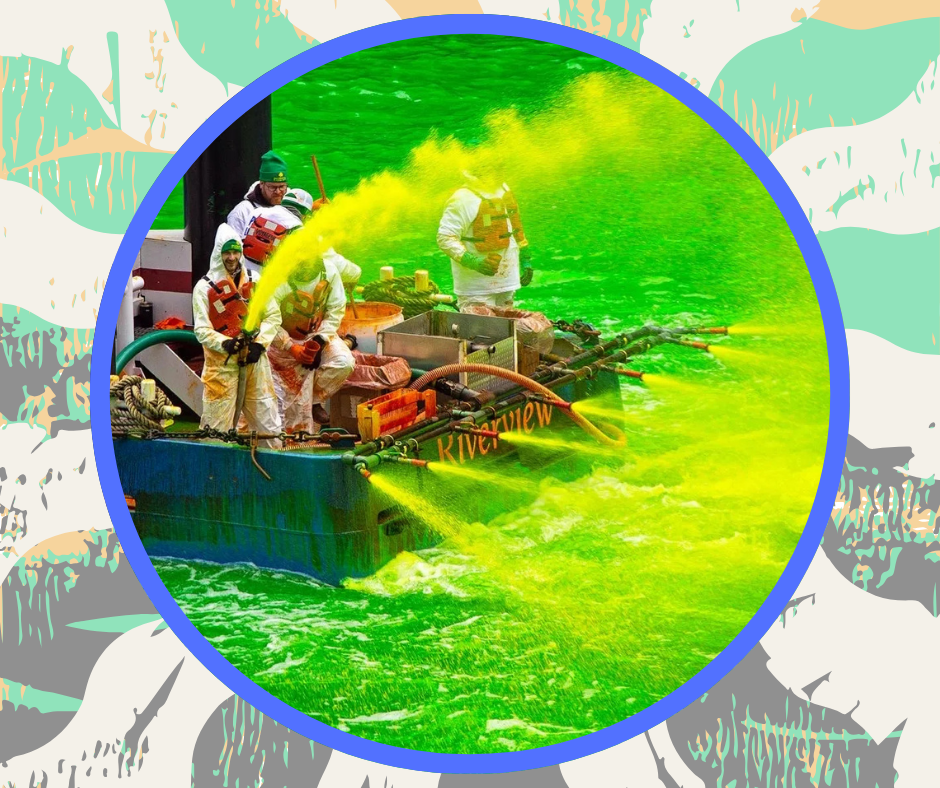
5. Evolution of Tradition
The history of dyeing the Chicago River green began as a small experimental initiative but has evolved into one of the city’s most spectacular and celebrated traditions. Over the decades, this tradition has transformed into a massive social and cultural event, attracting visitors from around the world.
Growing Popularity Over the Years
Since the first instance of dyeing the Chicago River green for St. Patrick’s Day in 1962, its popularity has surged. Initially, it was a niche event primarily celebrated by Chicago’s Irish community. However, it quickly became a defining symbol of the city, gaining national and even international recognition.
“It will get green, it will get fantastic!”
This phrase became a well-known expression throughout the city. On St. Patrick’s Day, the Chicago River transforms into the world’s most famous green river, drawing global media attention. The unique spectacle conveys the spirit of the celebration far beyond the city limits. Each year, over 250,000 spectators gather to witness the remarkable transformation. For many, it is a mesmerizing sight—a tradition that has become an integral part of St. Patrick’s Day festivities.
How It Became a Major Tourist Attraction
Over the years, the history of dyeing the Chicago River green has extended beyond a local tradition; it has become a cornerstone of Chicago’s tourism industry.
“It has left an unforgettable mark on the heart of Chicago.”
Alongside street parties, concerts, parades, and festivals, the dyed river is a central attraction. Visitors coming to Chicago for St. Patrick’s Day often consider this experience an essential part of their trip. Many restaurants and pubs offer exclusive packages, providing premium views of the river as it changes color.
Impact on Chicago’s Tourism and Economy
The history of dyeing the Chicago River green has grown into much more than a festive tradition—it now plays a vital role in boosting Chicago’s tourism and economy. In a city with deep Irish heritage, St. Patrick’s Day celebrations have evolved into a major international event. On this day, local businesses—hotels, restaurants, bars, and retail shops—experience a significant surge in activity, leading to notable economic gains. The influx of visitors also generates seasonal employment opportunities, providing a temporary boost to the local job market.
Over the years, the history of dyeing the Chicago River green has become deeply embedded in the city’s identity. It stands as both a point of pride for residents and a globally recognized emblem of Chicago’s rich cultural traditions.
In essence, this annual spectacle is far more than just a visual transformation of the river—it is a celebration of Chicago’s spirit, a powerful economic catalyst, and a cornerstone of its tourism industry. Year after year, it continues to attract global attention and reinforces the city’s legacy on the world stage.
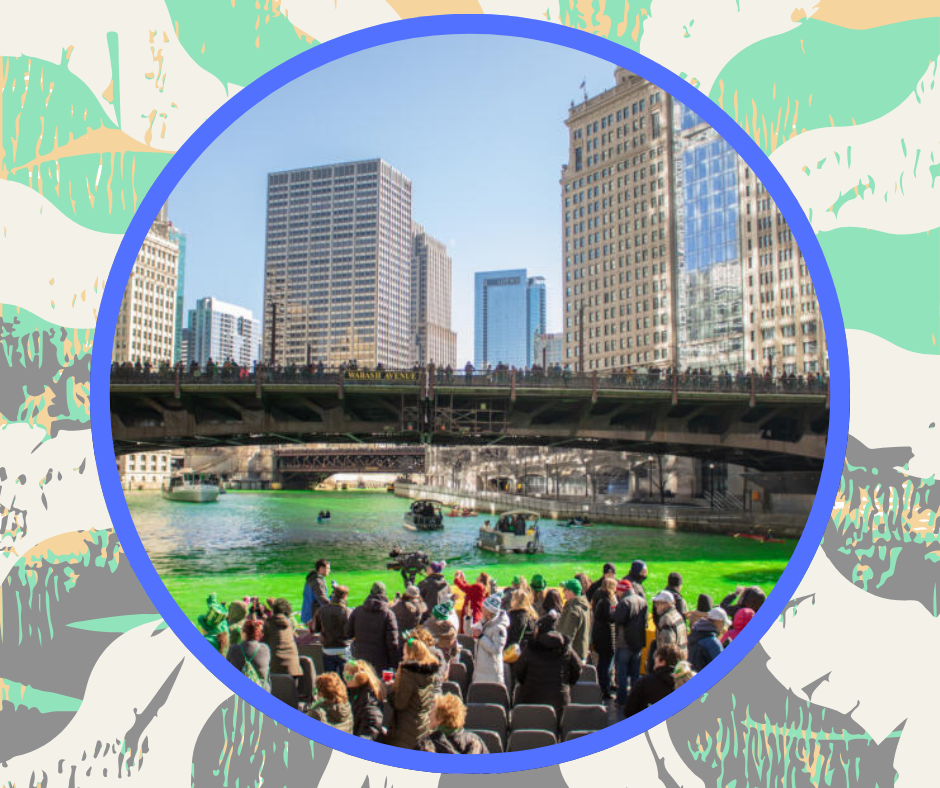
6. Environmental Concerns and Safety Measures
In a city where the festive spirit of St. Patrick’s Day fills every corner, concerns regarding the environmental impact of dyeing the Chicago River green have also surfaced over time. The dyes originally used were not entirely safe, presenting a new environmental challenge for the city. Urban planners and responsible officials became increasingly concerned about the potential risks.
Initial Environmental Concerns
Despite being a fun and deeply rooted tradition, environmentalists raised concerns about the impact of dyeing the Chicago River green. The old dyes, particularly fluorescein dye, were toxic and posed a threat to the river’s ecosystem. Aquatic life, including fish and other organisms, suffered adverse effects due to the chemicals used.
“Let it be vibrantly green, but protecting nature is equally important!” — This sentiment was voiced by various environmental organizations.
Moreover, the Chicago River is one of the city’s major water bodies, and turning it green on such a large scale presented a significant challenge. As the tradition gained popularity, people from other regions began considering similar initiatives, raising concerns about the broader ecological consequences if other cities followed suit. Thus, measures had to be taken to ensure water pollution control while preserving the city’s biodiversity and maintaining the overall health of the ecosystem.
Transition to Eco-Friendly, Biodegradable Vegetable-Based Dye
The Chicago authorities and local environmentalists quickly decided that switching to eco-friendly, biodegradable vegetable-based dyes was necessary.
“Just as trees keep the earth alive, this new dye will keep the river green while safeguarding nature.” — With this belief, the city gradually adopted safer dyes.
This transition is believed to have taken place sometime between 1962 and 1970, marking a significant milestone in making the tradition environmentally sustainable.
Role of Environmental Organizations in Monitoring the Dyeing Process
This shift in approach set a new standard for Chicago, and environmental organizations played a key role in overseeing the process.
“Our primary responsibility is to keep the river clean while preserving the environment!” — This mindset drove local environmental groups to closely monitor the tradition.
Friends of the Chicago River, a local environmental organization, has been instrumental in ensuring that the dye used is safe, environmentally friendly, and does not harm the city’s biodiversity. They confirm that the river’s water clears up quickly after the dyeing process, leaving no long-term impact on the ecosystem.
Thanks to this environmentally conscious approach, the history of dyeing the Chicago River green is now viewed from a scientific perspective as well, making Chicagoans proud of their unique tradition. This initiative has reinforced the belief:
“The river’s cool waters, filled with green hues, will continue to protect the environment—we hope this always remains true.”
Safety Measures and Future Plans
Despite environmental concerns, the tradition has continued, as Chicago authorities and environmental groups remain committed to ensuring that the dyeing process is completely safe and aligned with long-term environmental benefits. The tradition remains a crucial part of Chicago’s culture for both residents and tourists, and the city is dedicated to adopting even more sustainable measures in the future.
“This is a spectacle, a joy, but our responsibility to the environment always comes first!”
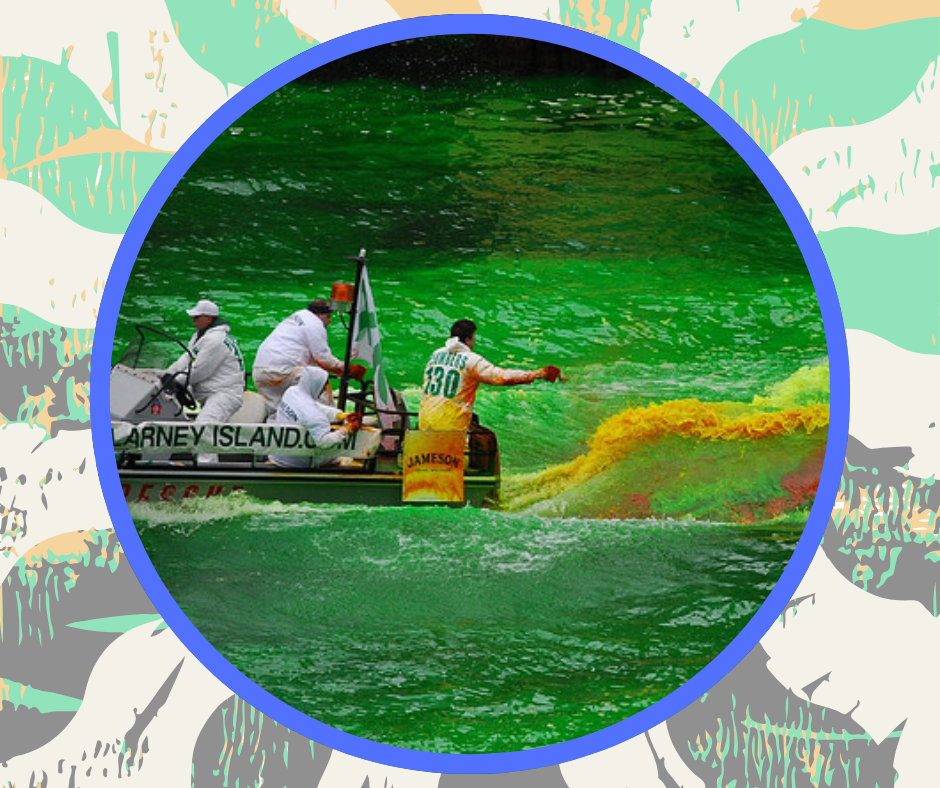





2 Comments
The Ultimate Guide to Saint Patrick’s Day Deals in 2025 – Snag the Best Discounts Like an Irish Pro! - Social Media Caring
[…] more Irish-themed inspiration? Don’t forget to check out The History of Dyeing the Chicago River Green—one of the most iconic Saint Patrick’s Day […]
Saint Patrick’s Day What is It? History, Meaning, and Global Celebration in 17/03 - Social Media Caring
[…] of the most famous traditions takes place in Chicago, where the city dyes the Chicago River green. This practice started in 1962, and today, it remains one of the most visually stunning aspects of […]